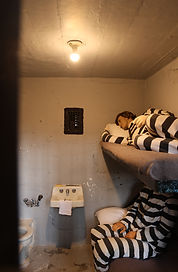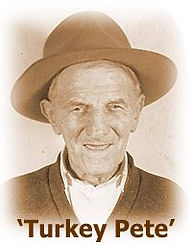Old Montana Prison

Guided and self-guided tours lead you through the intimidating Cell House and into the chilling slide bar cells and black box of Maximum Security. See what it was like to live amongst the turreted stone towers and iron gates at the “Prison Life” photo exhibit, then view the galloping gallows, currently located in the Clark Theater.

Stout iron bars slammed shut and locked for the first time on July 2, 1871. On that day, Montana’s Territorial Prison in Deer Lodge incarcerated its first occupant.
Guards no longer occupy the turrets set in each corner of the The Wall. The thud of heavy footsteps marching along the topmost barbed-wire- enclosed walkway is no longer heard. Emptied of prisoners in the late 1970s, the buildings stand now as silent sentinels to justice, a museum complex dedicated to law enforcement. Now open to the public for most of the year, this museum presents a chilling, bleak glimpse at life behind bars. A pamphlet distributed by the museum interprets each building and how it was used. Guideposts state the facts in a few brief sentences.
Guns and shackles and restraints can be viewed behind mesh partitions, along with artwork prepared by former inmates, and lethal weapons fashioned from kitchen forks and simple tools. Daily log sheets, in glass cases, describe in detail how guards and prisoners alike spent their days. Permission had to be granted by state authorities to grow mustaches, and there were written guidelines as to permissible length and care.
One display shows sturdy work shoes with concrete soles instead of leather ones. These shoes, weighing 20 pounds each, were ordered to be worn by convicts thought to be potential escapees.
Convict labor built large portions of the prison compound. Over time, inmates fashioned 1.2 million bricks by hand for use in erecting the original 1896 cell house and other buildings. Stone was quarried nearby and hauled to the site. Convicts cut the timbers and dug the lime for use in cement.



Inside the cell blocks are corridors painted a drab industrial gray, a broad yellow stripe along the floor defining the prisoner’s walkway.
The basement shower room is cold and damp, a dripping spigot the only sound. Heavy metal doors in the solitary confinement cells block out all light and sound. These doors insulate the guards on duty inside steel mesh cages from the rage of the isolated men.
Not all the memorabilia is without humor or humanity. Cell No.1 was occupied by Paul “Turkey Pete” Eitner. Convicted of murder and sentenced to life in 1918, Turkey Pete became a model prisoner and was placed in charge of the prison turkey flock. Losing touch with reality, at one point he “Sold” the entire flock for the sum of 25 cents per bird, beginning a new career as the prison entrepreneur.
Humoring his mental condition, inmates were allowed to print Eitner checks in the prison print shop and he was permitted to “purchase” the prison and run it from his cell. He “paid” all prison expenses and “paid” the guards salaries. At age 89, Turkey Pete died in 1967 after 49 years behind bars. At his death, Cell No 1 was retired from use. His was the only funeral ever held within the walls of the prison.
During its tenure, visitors entered the compound from Main Street, passing through arched doorways cut in the solid, high walls, into a small inner room. Here, a hole cut in the ceiling could open and the guard would pass down a key on a long rope. The key could open only the second door into the grounds of the prison.
Surrounded by chain link, steel mesh, brick, concrete and barbed wire, it is a relief to conclude the tour and step into the grassy center yard. Scratched into the bricks in one sheltered corner are names, dates and prison numbers, a reminder of men serving out their time.
A flagpole stands in the middle of the yard, the guy wires for the flag snapping against the post, the pulley mechanism clicking rhythmically in time. Wind whines through chain link fencing, trapping scraps of paper against the fence.

.png)
.png)


